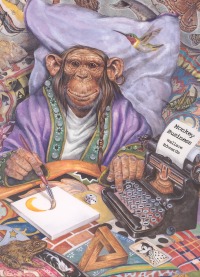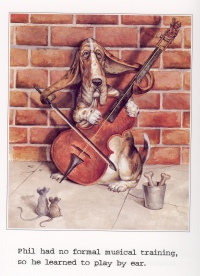| ________________
CM . . .
. Volume XI Number 3 . . . . October 1, 2004
excerpt:
Edwards, winner of the 2002 Governor General's literary award for Children's Literature - Illustrations with Alphabeasts, has created another exceptional picturebook which will delight both children and adults. As the definition found in the excerpt indicates, Edwards' subject matter is idioms, 26 of them to be exact. Each idiom is dealt with on a single page that is principally occupied by an illustration rendered in watercolour, coloured pencil and gouache. Each of Edwards' illustrations is a literal rendering of the idiom contained within a sentence or two found at the bottom of the page. For example, "Forbes had no intention of sharing his cupcake - he had a real sweet tooth," is accompanied by an illustration of a walrus wearing a party hat and holding a balloon; however, a candy cane has replaced one of his tusks. "Eloise had a craving for snails, but she accidentally opened a can of worms" presents a spoon-wielding Eloise, a fish who is sitting in her bathrobe at the kitchen table in the middle of the night. Before her is a bowl out of which is crawling a worm and next to the bowl is an opened, but unlabelled can from which more nightcrawlers are escaping. The book's closing idiom is appropriately, "to draw things to a close," and it repeats the cover illustration with the exception that the typed page in the typewriter now asks readers, "Did you find the monkey on every page?" Because this illustration incorporates elements from each of the book's other 25 illustrations, as a cover illustration, it foreshadows the book's contents, and, at the end, it truly "draw[s] things to a close."
Edwards' illustrations are full of detail and merit many viewings in order to "see" how much is actually there. The bull in a china shop does not just have a vase stuck on his hoof, but his situation is likely to get much worse for, unknown to him, his cane, tail and horns are all about to bring down more pieces of pottery and china. As well, one of his shoelaces is untied. A tiger slinking out a cloth bag is the focal point of the illustration for the statement, "Although Mumford had promised not to gossip, he let the cat out of the bag." Readers seeking the page's monkey will quickly see two in framed pictures on the wall. However, additional searching will reveal a third carved into the table's pedestal, and when the three monkeys are put together, readers can see how Edwards has tied them into Mumford's promise not to gossip via not seeing, hearing or speaking. In the "fish out of water," there is more than one fish out of the water, and there is more than one "wolf in sheep's clothing," facts that Edwards does not share with his readers. As a reviewer, I could only wonder what else I had missed. Monkey Business definitely has a wide grade/age audience and offers numerous curricular tie-ins, the most obvious being in language arts and art. A most worthy purchase. Highly Recommended. Dave Jenkinson teaches courses in children's and YA literature at the Faculty of Education, the University of Manitoba.
To comment
on this title or this review, send mail to cm@umanitoba.ca.
Copyright © the Manitoba Library Association. Reproduction for personal
use is permitted only if this copyright notice is maintained. Any
other reproduction is prohibited without permission.
NEXT REVIEW |
TABLE OF CONTENTS FOR THIS ISSUE
- October 1, 2004.
AUTHORS |
TITLES |
MEDIA REVIEWS |
PROFILES |
BACK ISSUES |
SEARCH |
CMARCHIVE |
HOME |

 The book's title also introduces a continuing visual thread which runs throughout the book. The opening idiom is "monkey business," and Edwards has concealed a monkey somewhere in the illustrations of the remaining idioms. In some cases, these monkeys are quite easy to locate, but others are much more challenging and Edwards does not provide a key. The book's final page defines, in alphabetical order, the 26 idioms.
The book's title also introduces a continuing visual thread which runs throughout the book. The opening idiom is "monkey business," and Edwards has concealed a monkey somewhere in the illustrations of the remaining idioms. In some cases, these monkeys are quite easy to locate, but others are much more challenging and Edwards does not provide a key. The book's final page defines, in alphabetical order, the 26 idioms.